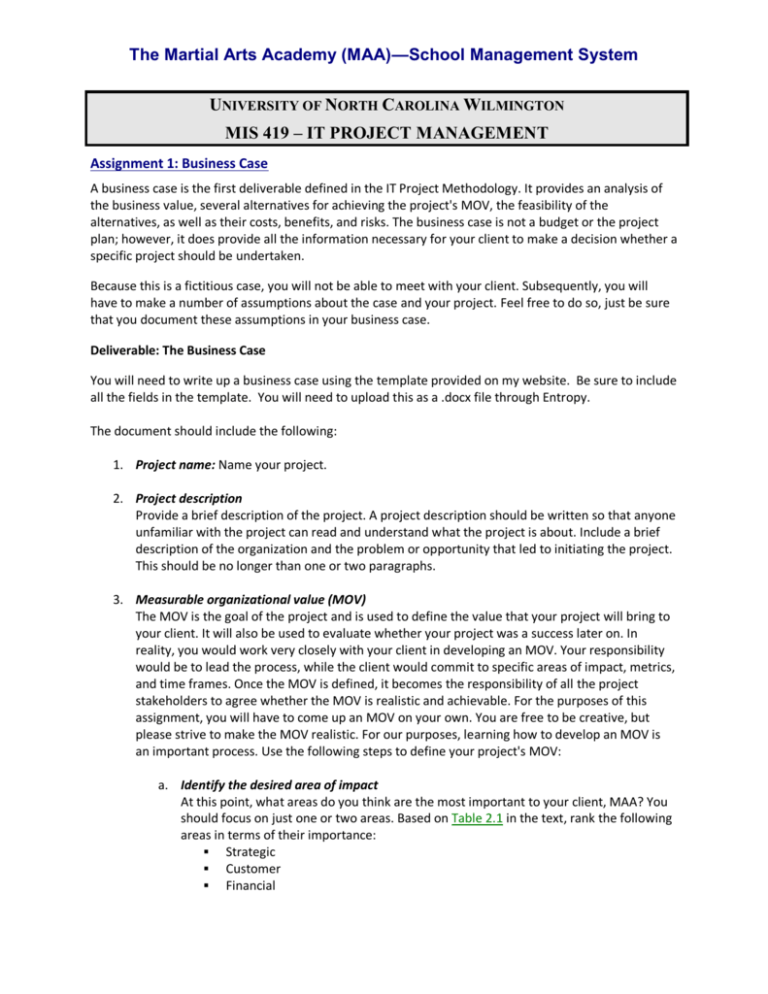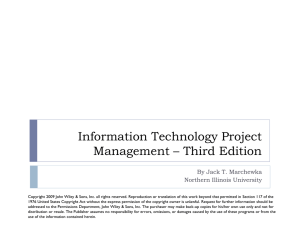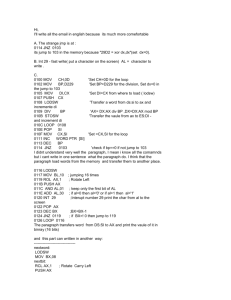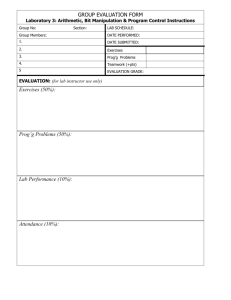MAA School Management System Business Case Assignment
advertisement

The Martial Arts Academy (MAA)—School Management System UNIVERSITY OF NORTH CAROLINA WILMINGTON MIS 419 – IT PROJECT MANAGEMENT Assignment 1: Business Case A business case is the first deliverable defined in the IT Project Methodology. It provides an analysis of the business value, several alternatives for achieving the project's MOV, the feasibility of the alternatives, as well as their costs, benefits, and risks. The business case is not a budget or the project plan; however, it does provide all the information necessary for your client to make a decision whether a specific project should be undertaken. Because this is a fictitious case, you will not be able to meet with your client. Subsequently, you will have to make a number of assumptions about the case and your project. Feel free to do so, just be sure that you document these assumptions in your business case. Deliverable: The Business Case You will need to write up a business case using the template provided on my website. Be sure to include all the fields in the template. You will need to upload this as a .docx file through Entropy. The document should include the following: 1. Project name: Name your project. 2. Project description Provide a brief description of the project. A project description should be written so that anyone unfamiliar with the project can read and understand what the project is about. Include a brief description of the organization and the problem or opportunity that led to initiating the project. This should be no longer than one or two paragraphs. 3. Measurable organizational value (MOV) The MOV is the goal of the project and is used to define the value that your project will bring to your client. It will also be used to evaluate whether your project was a success later on. In reality, you would work very closely with your client in developing an MOV. Your responsibility would be to lead the process, while the client would commit to specific areas of impact, metrics, and time frames. Once the MOV is defined, it becomes the responsibility of all the project stakeholders to agree whether the MOV is realistic and achievable. For the purposes of this assignment, you will have to come up an MOV on your own. You are free to be creative, but please strive to make the MOV realistic. For our purposes, learning how to develop an MOV is an important process. Use the following steps to define your project's MOV: a. Identify the desired area of impact At this point, what areas do you think are the most important to your client, MAA? You should focus on just one or two areas. Based on Table 2.1 in the text, rank the following areas in terms of their importance: Strategic Customer Financial The Martial Arts Academy (MAA)—School Management System Operational Social b. Identify the desired value of the IT project Value to an organization can come from doing something better, faster, or less expensively (i.e., cheaper). On the other hand, it can come from growth by doing more of something that the organization is currently doing (e.g., increase market share). The next step in developing an MOV is to identify the project's potential value to the organization. In general, a project should focus on delivering one or two of the following types of value. Better? Does MAA want to do something better? For example, is improving quality important to your client? Faster? Does MAA want to do something faster? For example, does your client want to increase speed, efficiency, or reduce cycle times? Cheaper? Does MAA want to reduce costs? For example, is cutting costs important to your client? Do More? Does MAA want to do more of something? For example, does your client want to continue the growth of something that they are currently doing? c. Develop an appropriate metric Once you have identified the desired area of impact and value to the organization, the next step is to develop a metric that sets a target and expectation for all of the project stakeholders. For example, if an organization desires to do more of something that is strategic to the organization (i.e., increase market share of a particular product or service), then the organization's management may feel that an IT project will bring value to the organization if they can grow their current market share from 10 to 25 percent. On the other hand, a bank may be able to process a loan request within 10 days. By developing and implementing a proposed information system, the bank's management may believe that it can reduce the cycle time of processing a loan to 24 hours or less. This would allow the company to do something faster operationally. Therefore, it is important to come up with a quantitative target. This target should be expressed as a metric in terms of an increase or decrease of money (dollars, euros, etc.), percent, or a specific numeric value. d. Set a time frame for achieving the MOV Once you have identified the area of impact, value to the organization, and an appropriate metric, you need to set a time frame for achieving the MOV. Keep in mind that this time frame may not coincide with the scheduled completion of the project work. For example, reducing the time to process a loan within 24 hours may be achievable once the system is implemented, but instant growth of market share from 10 to 25 percent may take a few months. Setting the time frame for achieving the MOV can be determined by asking the question: When do we want to achieve this target metric? e. Summarize the MOV in a clear, concise statement or table Once the area of impact, value, metrics, and time frame are agreed on, the MOV should be summarized so that it can be clearly communicated to all of the project stakeholders. The MOV can be summarized in a statement by completing the statement: This project will be successful if? On the other hand, a table format may be more appropriate for The Martial Arts Academy (MAA)—School Management System summarizing the MOV if it has a growth component over two or more time periods. Keep in mind that the MOV should tell everyone what the project will achieve, not how it will be achieved. The MOV should focus on the organization, not the technology that will be used to build or support the information system or the how long the project will take or how much it will cost. 4. A comparison of alternatives To keep things simple, you may consider three alternatives for your client: maintain the status quo (i.e., MAA will keep the current paper-based system), purchase a martial arts school management software package, or build a stand-alone database management system. The first alternative means that MAA will keep their current system. Using a Web search engine, you can do a search, for example, on "martial arts school management software," but don't just choose the first one listed by the search engine. If more than martial arts school management software package exists, then select one that you feel will be the best option for your client. Create a scoring table to compare each of the alternatives based on the following criteria: a. Advantages and disadvantages Discuss the pros and cons of keeping the current paper-based system versus purchasing an existing software package or developing a custom database application. b. Estimated cost This can be only a rough estimate at this time. Later on, you will develop a detailed project schedule and budget that can be compared to your ballpark estimate now. If MMA purchases a software system or develops a database management system, they will need to purchase a laptop computer or desktop workstation in addition to the cost of the software. MMA has wireless Internet access that is part of their utilities paid for by the landlord who owns the building. Keep in mind that there is a cost involved with maintaining the current paper-based system. You can use the Web to come up with the cost of any hardware or additional software that will be needed. c. Expected benefits This may be the most important section since Geoff and Julie expect to receive value for the time, money, and resources that will be invested. Be sure to list and discuss the tangible and intangible benefits for the three alternatives. 5. Recommendation At this point you may have more questions than answers and feel that you are being forced to make many assumptions. This is common for many real project teams and consultants at this stage of the project. You'll gain confidence from experience, doing good research, and paying attention to the details. Now you are ready to make a recommendation to your client and support it. Given the limited amount of information and time, you should still be confident that your recommendation provides the best value to MAA and that the benefits outweigh the costs. Be sure that you not only recommend one of the three alternatives, but that you provide support based on your analysis to back it up. The client will make a decision whether to continue to the next phase of the project. If the project continues, a detailed schedule and budget will provide clearer picture of the project's true costs, and another decision whether to fund and support the project in the next phase will be made.






